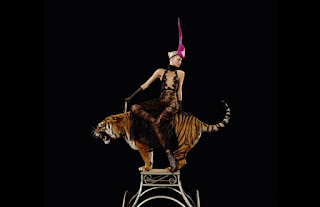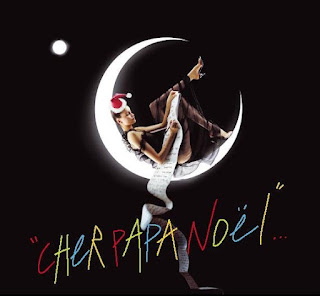Image courtesy of: http://livre.fnac.com/
“I regularly ask myself about the status of my work and the classification of what I do. How relevant is my work, and does it correspond to the life of an artist - even as I conceived it? Is it art or something else? I still don't know if I'll ever find an answer.”
~ Jean-Paul Goude
Image courtesy of: http://www.alteregobkk.com/
Jean-Paul Goude was born in a suburb of Paris in 1940, to an American mother and a French father. Both of Goude's parents were 'showbiz' people in New York. His mother ran a dance school, possibly instilling in the young Goude a fascination with the human body and its rhythmic movement - especially in dance. As a youth, Goude had initially intended to become a ballet dancer, but his body did not conform to the regle d'or or the golden rule of proportion and so, he decided to quit ballet. It is said that his artistic talents were evident from an early age. At any rate, he was enrolled at L'École Nationale Supérieure des Beaux-Arts in Paris. Afterwards, Goude embarked on his career as an illustrator. Then, in 1968, Harold Hayes, editor of US Esquire Magazine from 1963-1973 asked Goude to art direct a special edition of the magazine in celebration of its 75th issue. Fresh from Paris, Goude began to work there full-time, becoming an art editor even though he had little experience in layouts. At the age of 25, he became one of Esquire's creative art directors; by which time, he had established himself as a first-class artist.
Jean-Paul Goude in Paris ~ 1981
Image courtesy of: http://www.younggalleryphoto.com/
Image courtesy of: http://www.wwd.com/
Album Covers & Commercials:

Cristina ~ Sleep It Off
Image courtesy of: http://blog.albumartexchange.com/
Bulletproof Heart
No profile on Jean-Paul Goude is complete without citing his most intimate collaboration, that of the mythical Pygmalion and Galatea, which began in New York and at the height (and heady nights) of the Disco era. It was there that he ran into Grace Jones one evening, then a young Disco diva, after one of her performances at the celebrated Studio 54. The two quickly became lovers with the added bonus that Grace gained a much-needed new manager with a fertile imagination and the vision to execute it; he was a man who would not only become the father of her son but also play with her androgyny, moulding her image into a gay icon. Here was the perfect vehicle to Goude's exuberant imagination: stage-managing outrageous live shows and creating groundbreaking album covers with a submitting, perfectly willing and unafraid muse. For one cover, Island Life, he manipulated Jones's image, through his signature 'cutting and pasting' method (by hand and without the benefit or convenience of modern-day computer softwares), into an impossible pose - a pose which has been attempted and parodied endlessly over the years.
Nightclubbing
Both images above are courtesy of: http://mondomoda.wordpress.com/
Image courtesy of: http://www.artnet.com/
Below: the completed version of the Slave album cover
Above image is courtesy of: http://dance.kazaa.com/
Below: the evolution of the Slave to the Rhythm album cover
Image courtesy of: http://escarradordedavidmotta.blogspot.com/
“I photographed her in a variety of positions, which I combined into a montage that made it possible to show her simultaneously full-frontal and in profile, like an Egyptian bas-relief,” Goude says. “Then, having transferred the montage to photographic paper, I used it as the preliminary sketch for a painting meant to give the photographic illusion that she alone, like a contortionist, could assume the pose, though on a closer look you can see that from a strictly anatomical point of view the pose is impossible to achieve.”
It’s an approach Goude has adopted with many of his muses, adapting their images to show what he describes as his real conception of their beauty, not the one directly visible. (Cited from: http://www.bjp-online.com/, 2010)

Above & below:
The creative process of the Grace Jones's Island Life album cover
The creative process of the Grace Jones's Island Life album cover
Image: http://www.boingboing.net/
Image courtesy of: http://www.qompendium.com/
Grace Jones after
Image courtesy of: http://www.hastedhunt.com/
Miscellaneous:
Former YSL muse, Mounia
Laetitia Casta, 2003
The above two images are courtesy of: http://fr.modefix.com/
(Above left: "Allegorie de la Mode" ~ 1998)
The above two images are courtesy of: APARTE
Above left image, courtesy of: http://www.france5.fr/ | Above right image, courtesy of: Le Point C.
(Above right: Azzedine Alaïa & Farida Khelfa ~ 1985)
Perhaps it is the most prestigious and important commission of Goude's career to date: in 1989, President Mitterrand asked Goude to organize and oversee the Bicentennial parade on the 200th anniversary of Bastille Day, that spark which ignited the fire of the French Revolution. But in true Goude-fashion, he mixed French and African rhythms, doused the British contingent with water (because “everyone knows it always rains in England”), and asked Senegalese tribal dancers to interpret Swan Lake. In an interview with I.D. Magazine's Erin Flaherty in 2006, Goude's memory of that night is as follows, "There were a million people - it was a night to remember because France was on this positive high. The multiracial utopia was the thing to do, and that night there was not one incident, not one fight. Nothing."
(Cited in: http://www.id-mag.com/, 2006)
Goude's notion or ideal of women, especially ethnic women, have sometimes followed rather cartoonish racial stereotypes, and the name of his first book – Jungle Fever, published in 1982 – also attracted criticism. He argues he’s a man of form, and that his work tackles a political problem in an aesthetic way. (Cited from: http://www.bjp-online.com/, 2010)
(Cited in: http://www.id-mag.com/, 2006)
July 14, 1989, Bastille Day parade - Paris
Image courtesy of: http://secondlifeshrink.com/
A Jean-Paul Goude creation used by in the 1989 bicentennial Bastille Day parade
(Displayed as part of the Goudemalion exhibition at Les Arts Decoratifs ~ Paris)
Top image, courtesy of: FOTO E DITËS | Middle imgage, courtesy of: fashionblog.am
Bottom image, courtesy of: ParisMatch
Goude's notion or ideal of women, especially ethnic women, have sometimes followed rather cartoonish racial stereotypes, and the name of his first book – Jungle Fever, published in 1982 – also attracted criticism. He argues he’s a man of form, and that his work tackles a political problem in an aesthetic way. (Cited from: http://www.bjp-online.com/, 2010)
Vanessa Paradis
Image courtesy of: http://playfast.exblog.jp/ 
Naomi Campbell, before
The two images above are courtesy of: http://lamutamu.com/

Grace Jones ~ New York, 1980
Top left image, courtesy of: Le Point C. | Top right imge, courtesy of: fashionblog.am
Bottom image, courtesy of: Delphine à Paris
Video courtesy of: BDM675 ~ YouTube

On the set of Coco L'esprit de Chanel 
Naomi Campbell, after
Image above is courtesy of: http://ffffashionfabulousfrance.blogspot.com/
Image above is courtesy of: http://ffffashionfabulousfrance.blogspot.com/
Image courtesy of: http://www.bjp-online.com/
Grace Jones ~ New York, 1980
Top left image, courtesy of: Le Point C. | Top right imge, courtesy of: fashionblog.am
Bottom image, courtesy of: Delphine à Paris
Video courtesy of: BDM675 ~ YouTube

Commercial video ~ 1991
For Chanel's Coco campaign, Goude put Vanessa Paradis in a birdcage because he thought she looked like Tweety bird.
The above four images are courtesy of: http://www.talk.vanessaparadis.info/

Coco: L'Esprit de Chanel ~ 1991
Image is courtesy of: http://community.livejournal.com/
Goude’s first ad was a TV spot for Lee Cooper jeans in 1982, which he tackled in typically irreverent style, creating a 10-minute mini opera set to Stravinsky’s Rites of Spring. He’s also shot TV ads for Kodak, Azzedine Alaïa, Perrier, Cacharel and Chanel, to name just a few.
Coco: L'Esprit de Chanel ~ 1991
Image is courtesy of: http://community.livejournal.com/
As a child, he says, his father would try to teach him the difference between fact and fiction, while his mother would argue, “Let the kid dream”. Then his father would say, “No, this is ridiculous. This child has to know what’s right and wrong; what is fantasy and what is reality”. And with that “my mother and I would start crying”. Luckily, he never quite got the hang of it.
And perhaps that’s the point. With Goude you don’t get reality, you get a slice of his singularly creative mind.
(Cited from: http://www.bjp-online.com/, 2010)
Jean-Paul Goude: So Far, So Goude
The above two videos are courtesy of: f4ust85 - youtube.com

Advertisements & Editorials:
Laetitia Casta as Mae West
Image courtesy of: http://fashionsmostwanted.blogspot.com/

Image courtesy of: http://www.egodesign.ca/

Image courtesy of: http://www.egodesign.ca/
Queen of the Art Scene
(Harper's Bazaar ~ September 2012)
Image courtesy of: Harper's Bazaar
"An Haute-Couture Fantasy"
John Galliano for Harper's Bazaar ~ December 2003
(Christian Dior Autumn-Winter 2003 Haute Couture)
The above two images are courtesy of: Mr. Gallegos
The above eighteen images are all courtesy of: http://www.etoday.ru/
Video courtesy of: Rue Faubourg Style TV
Video by Chanel
The above two videos ~ YouTube
Jean Paul Gaultier
Image courtesy of: ILLUSTRATION at a Mag.in
Donatella Versace & Linda Evangelista
Image courtesy of: MAUD home
Azzedine Alaïa
Image courtesy of: The Ground Magazine
Björk by Jean-Paul Goude:
Mixte Magazine - October, 2007
Above left image, courtesy of: http://lexposure.net/ | Above right image, courtesy of: APARTE
Mixte Magazine - October, 2007
The above three images are courtesy of: http://girlalamode.blogspot.com/
The Galeries Lafayette advert campaign:
Image courtesy of: http://jpdubs.hautetfort.com/
Image courtesy of: http://lesanimauxducinema.centerblog.net/
Image courtesy of: http://www.harpersbazaar.com/
Jean-Paul Goude's most celebrated print campaigns have been for Galeries Lafayette, the leading Parisian department store he’s worked with for more than 10 years. The company is no stranger to strong art directors – previous campaigns were directed by Jean Widmer (a student of Bauhaus teacher Johannes Itten) and Peter Knapp – but with access to “Mr Galeries Lafayette himself,” Goude has been given considerable creative freedom. He’s opted to shoot the on-going adventures of “a comic book character, half way between Herge’s Tintin and a heroine of an early Pearl Buck novel”.
(Cited from: http://www.bjp-online.com/, 2010)
Image courtesy of: http://www.harpersbazaar.com/
Jean-Paul Goude's most celebrated print campaigns have been for Galeries Lafayette, the leading Parisian department store he’s worked with for more than 10 years. The company is no stranger to strong art directors – previous campaigns were directed by Jean Widmer (a student of Bauhaus teacher Johannes Itten) and Peter Knapp – but with access to “Mr Galeries Lafayette himself,” Goude has been given considerable creative freedom. He’s opted to shoot the on-going adventures of “a comic book character, half way between Herge’s Tintin and a heroine of an early Pearl Buck novel”.
(Cited from: http://www.bjp-online.com/, 2010)
Image courtesy of: http://pourelles.bienpublic.com/
Image courtesy of: ttp://artbuyersources.blogspot.com/
Image courtesy of: http://www.gosee.de/
Image courtesy of: http://bananas-models.blogspot.com/

The 1999 Chanel No. 5 print campaign:
The above eighteen images are all courtesy of:
(Portrait of Jean-Paul Goude with the mask of Grace Jones)
Above left image, courtesy of: Goudemalion | Above right image, courtesy of: Tiger Magazine
Suggested readings:
Jungle Fever (1982), by Jean-Paul Goude: Quartet
So Far, So Goude (2005), by Jean-Paul Goude & Patrick Mauriés and Tom Hedley: Assouline
The Goude Touch (2010), by Jean-Paul Goude & Patrick Mauriés: Thames & Hudson






































































.jpg)





















No comments:
Post a Comment